Where to sell digital products: The best platforms for creators
By Kaleigh Moore August 8, 2023
People are flocking to the digital economy for more freedom, flexibility, and, ideally, more dollars.
And it’s working. According to Goldman Sachs Research, “the increase in digital media consumption and the advent of technology…has lowered barriers to content creation.” By 2027, the creator economy could be worth half a trillion dollars.
Content creators are taking advantage. Many of them have already abandoned the nine-to-five grind. They’re now working for themselves.
But what if you sell a service instead of a product? Suddenly you find yourself facing a bottleneck. Your work still requires effort, time, and your personal presence.
That’s why it feels like you gave up the nine-to-five…just to start a new nine-to-five.
The solution is to leverage your time by switching from services to products. What if you could build a repeatable digital product that sells itself while you sleep? You’d decouple your labor from your income.
But before you do, you’ll have to know a few things about digital products:
- What you can sell?
- What sales strategies are succeeding?
- Where are all the sales happening right now?
Let’s answer all three with special emphasis on that critical question: where?
What is a digital product?
A digital product is an electronic asset you can sell with little to no cost of duplication. Typically, a digital product may be a piece of media like an eBook. Users can download the product and put it to use on their device of choice.
What are examples of digital products?
If you think it sounds niche, consider this: Amazon sells approximately half a billion eBooks per year. And 83% of all video game sales are completely digital.
Online courses, training videos, webinars, eBooks, music, PDFs, digital art, widgets, and apps. Digital products are so ubiquitous, we barely think of them as digital anymore.
We just think of them as products.
Digital products are so popular, many creators “niche down” their services. You can sell training for unique markets because it’s so easy to find them now.
Example:
Take Leela Sinha, a coach offering leadership intensive for a specific personality type. Leela has a niche market, coaching “intensives,” or people with risk-taking tendencies.
Leela’s story reinforces why digital products are so popular now, but not from the buyer’s end. Buyers know how convenient it is to download a movie rather than order a DVD.
But consider Leela’s perspective. One day, Leela wrote a post on Facebook about gender inclusivity. All sorts of business owners responded, creating a storm of comments.
So Leela decided to capitalize and logged into AWeber.
Within six hours, Leela had an entirely new course on gender inclusivity.
Rather than selling coaching services, which would be time-intensive, Leela spent all of that time upfront. There was now a digital product capable of selling over and over again—without any additional work.
AWeber provided the platform to get Leela’s course up and running, ready to accept payments. Leela published the course with a link in the Facebook thread, which was still hot with incoming comments.
The ability to produce a digital product that quickly through AWeber “made all the difference,” according to Leela.
Where can you sell digital products?
You may notice a common thread with all of the examples above: most sales occur through a specific platform.
While you can create a PDF from scratch and sell it directly to customers, it’s not always ideal. You can create more value for your customers when your digital products also bring full-fledged experiences with them.
To unlock those experiences, you’ll need a digital platform to handle the grunt work.
That’s especially true if you’re not quite as Internet-savvy as Leela—at least not for the moment. So where do you start? Let’s explore the digital platforms for building digital products and selling them online.
AWeber
AWeber is a full-fledged email marketing provider. But it also offers a complete platform for creators selling digital products.
With AWeber, you can build email newsletters, send out courses via email, and connect platforms like Facebook, WordPress, and PayPal to run your entire digital product business.
Users may especially appreciate the landing page builder. Your landing page is a key cog in your digital product machine: it’s the “sales rep” capable of moving products, even while you sleep. Create a great landing page for your digital product and you’ve separated your income from your time.
After that, it’s simply a matter of traffic. And AWeber’s subscriber segment tools help you improve and hone your approach over time.
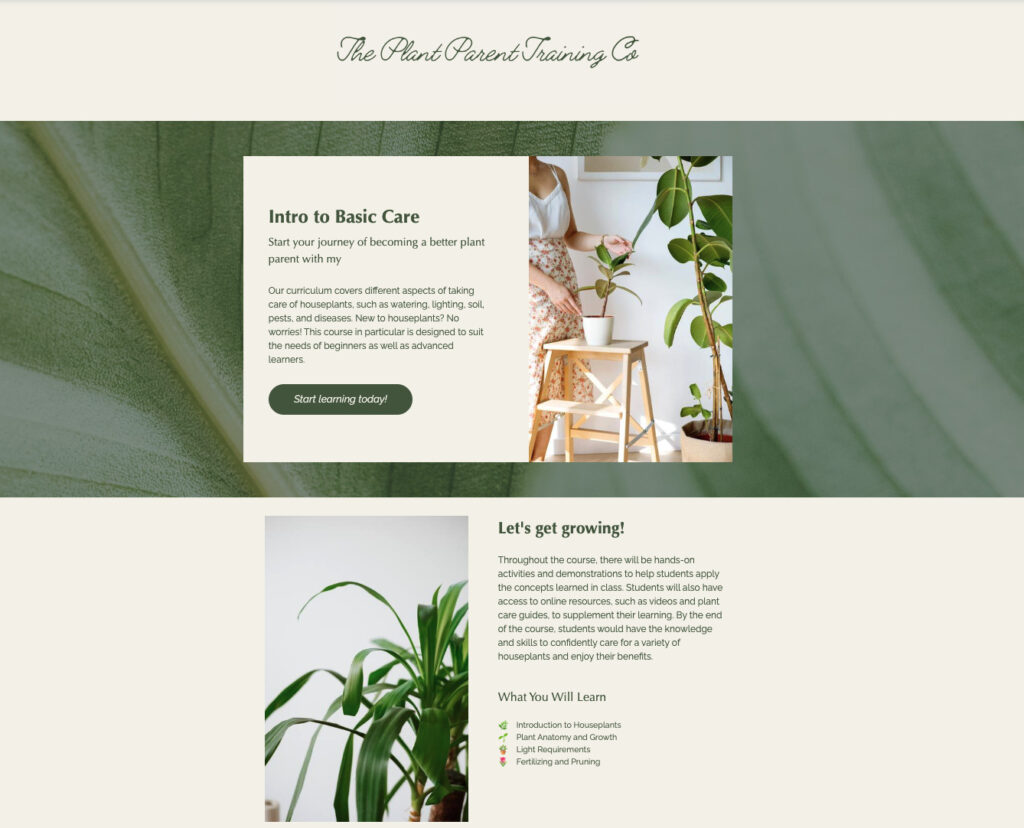
Who are they?
Think of AWeber as your modern-day storefront. But rather than offering a business card, you send visitors to a landing page.
From there, your landing page captures visitors with an email sign-up form. Users typically trade their email for a “lead generator” you offer—often a free digital product like an eBook.
Through AWeber, you can add your digital product and select a payment type (one-time? Subscription? Payment plans?). Then let the landing page handle the sales on your behalf.
AWeber’s landing page tools do most of the work for you, helping you build a visually consistent brand. You’ll look professional and capable.
And even if you sell your products on other platforms like Shopify, it’s a breeze to connect AWeber’s landing page tools to these products.
Main types of digital products sold
Anything digital works on AWeber, but products like eBooks and courses are especially popular with our creators.
Consider Alycia, a Zumba instructor struggling to get people to sign up for her classes. She turned to AWeber’s landing page builder. There she used a tool displaying her upcoming Zumba classes, which sparked customer interest.
Her email subscribers went up 100%.
Creator courses like Naomi DeRuiter’s are great ways to turn the bottleneck of coaching services into a leveraged business. DeRuiter set her AWeber landing page to repeat a free virtual cheesemaking class and increase her subscribers.
She only taught the class once. But her AWeber landing page is still signing up new subscribers.
Starting from pricing
With the free version of AWeber, you can try out one landing page with a small transaction fee—just 1%. Or, if you go for $20/month, you can build unlimited landing pages and reduce your transaction fees to 0.6%.
Examples
Elizabeth Resnick used AWeber to build Happy, Healthy, and Hot. Her niche? Coaching successful professionals on weight loss, fitness, and building a healthy lifestyle.
Resnick’s bread and butter had been 90-minute coaching sessions. These sessions had her giving helpful one-on-one advice. But given her limited schedule, Resnick knew she had two options if she wanted to grow. Either raise her prices sky-high or find a way to “productize” her services.
She chose the latter, using AWeber to build a community with group sessions. Now she could reach a greater audience with the same time investment. She also added digital products like recipes and meal plans.
Now her AWeber landing pages handle more of the work. Resnick funnels in traffic from her social media accounts.
As a result, she earns more money per hour without changing her core offering.
Why are they the best?
AWeber’s ideal for creators or anyone who wants to sell digital products while growing an email list. Landing pages can accomplish both at once. These pages capture email addresses while pushing digital products.
And it all happens without the creator lifting a finger.
Etsy
Main type of digital products sold
All over! Most think of Etsy as a tangible products store, with main categories like home decor, jewelry/accessories, clothing, wedding & party, or arts & collectibles.
Even so, there are more digital products on Etsy than people know. Products range from digital planners and Canva templates to eBooks and ChatGPT prompts.
A quick summary
Etsy is a massive platform: $2.5 billion in revenue in 2022 and still growing. Think of building an Etsy shop as planting your flag in a huge digital marketplace. It has its own ecosystem, including its own SEO rules.
Starting from pricing
Etsy pricing includes a 20-cent fee for each item you list, plus a 6.5% fee for everything you sell on Etsy. That number isn’t static, either; in fact, it’s gone up twice over the past several years.
Examples
Although the biggest Etsy success stories tend to be tangible stores, there’s no reason you can’t succeed with digital products. And the advantage of digital products is that you don’t have to spend time and money shipping the products to every corner of the world.
Take Ralu Patrea, who built a paperless planner on Etsy. Generating about $3,000/month with minimal expenses, it’s a business that scales—more customers don’t necessarily mean much more work for Patrea.
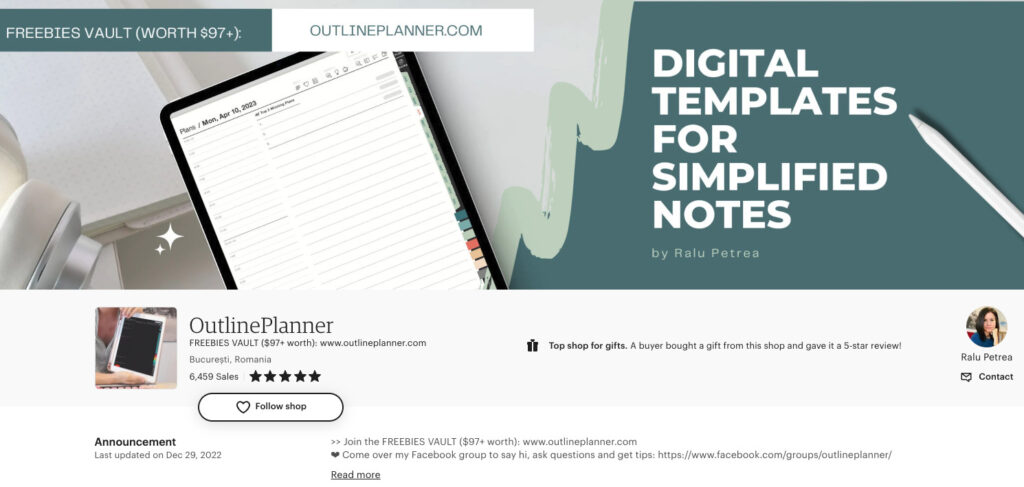
Overall impressions
Etsy may have a reputation for selling knick-knacks and home goods. But there’s also a thriving digital marketplace on Etsy worth exploring.
The fees are on the expensive side. And you’ll cede some control to Etsy since you have to play by their rules.
But those are the breaks if you want access to Etsy’s massive public marketplace.
Shopify
Main type of digital products sold
You can sell almost anything on Shopify. But the most common products are tangible goods like apparel, art and home decor, food and drink, and beauty and health products.
A quick summary
Shopify is great for people who want a platform for building a big-time store that scales. Selling apparel and physical goods? You’ll love the interface.
Starting from pricing
Shopify Pricing is $39/month flat for a basic small business, plus small transaction fees with credit card rates of 2.9% + 30¢ USD online, or 2.7% + 0¢ USD in person.
But since we’re talking about digital goods, the reduced in-person transaction fee likely won’t appeal to you. Expect to pay that 2.9% transaction fee plus 30 cents for every product you sell.
Examples
Cinnamon and Jason of Pixie Faire discovered a large niche in the doll clothing market and built their store up over decades, starting with an eBay store in 2008. Within about 18 months, they were publishing their own patterns.
Then they ran into the traditional bottleneck. They couldn’t scale this business without serious investments.
So they went digital. They’re now selling $600,000 a year through Shopify with downloadable PDFs for doll clothing patterns.
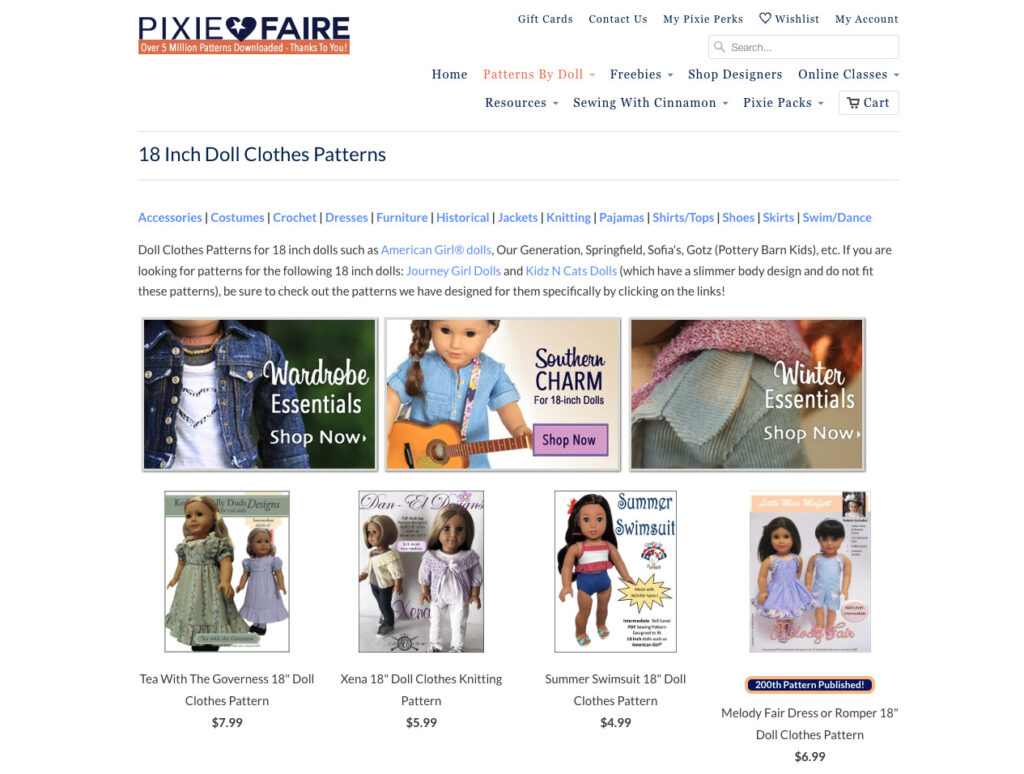
Overall impressions
Shopify is great if you want a store that scales—and a store you can call yours. But it helps if you already have traffic. It’s less a community and newsletter growth platform than a place to sell goods to an existing customer base.
Teachable
Main type of digital products sold
Teachable is all about online courses. This makes it a great platform for coaches who don’t want to repeat these courses—and need a way to stretch their time. It’s also a platform for setting up digital information products like podcasts and eBooks.
A quick summary
Think of Teachable as ideal for a specific type of creator: the coach who wants to keep teaching but doesn’t have the time to keep doing one-on-one sessions.
Teachable also supplements your time by offering tools like an AI curriculum generator. This reduces the friction it takes to build your first course.
Starting from pricing
Starting at $0/month makes for a low barrier to entry. But there’s also a $1-per-product and 10% transaction fee, which means Teachable will take a bite as soon as you start making sales.
Examples
Yoga classes take more work to scale. In a traditional setup, you can only charge as many students as you can fit into a room. That’s why Rachel Jesien went beyond the one-class-at-a-time paradigm and niched down.
She developed specialized daily yoga tutorials for people with specific problems like scoliosis. The niche made her teaching more relevant for unique customer segments. For Jesien, it meant collecting income without teaching every class herself.

Overall impressions
Teachable is a great option for coaches and other service-based businesses who need to turn their offerings into products.
Thinkific
Main type of digital products sold
Like Teachable, Thinkific is all about courses and educational digital products. It’s another avenue to explore if you need to turn a traditional service into a repeatable product.
A quick summary
Thinkific’s primary focus is course creation. You’ll also appreciate the community membership infrastructure. The tools are here if you want to adopt Elizabeth Resnick’s approach to a coaching community.
Starting from pricing
If you have just one course and one community, Thinkific is free. But if you want to stretch your legs—say with a custom domain—it will be $36/month. You should also watch for the transaction fees associated with your country.
Examples
Ellie Diop of Ellie Talks Money had a corporate job where she was in charge of a lot of big-time money decisions. When she was laid off, she turned to Thinkific because she knew she had specialized knowledge that was worth selling. To date, she’s taught over 3,000 students and collected seven figures in payments through the platform.

Overall impressions
Thinkific’s features may strike you as narrow, but it’s an intuitive way to build a creator course when you need help turning your knowledge into a product.
Gumroad
Main type of digital products sold
Memberships, digital products, and physical products rule the day on Gumroad. But it may be most famous for how quickly it can set up creators with digital products. It’s also a convenient platform for building subscriber-based communities.
A quick summary
Gumroad’s simple interface works on both ends: it’s easy for customers to buy and easy for creators to get started. It’s an ideal platform if you want to test new ideas on the Internet and gauge if there’s enough interest for what you’re selling.
Starting from pricing
With a 10% flat transaction fee, Gumroad does take a bite. But it’s also a beginner-friendly way to start: you only pay as you make sales.
Examples
Brian Hahn achieved success on Gumroad selling preparation guides for the bar exam. What initially began as a side hustle for Hahn eventually found its audience, generating six figures of income.
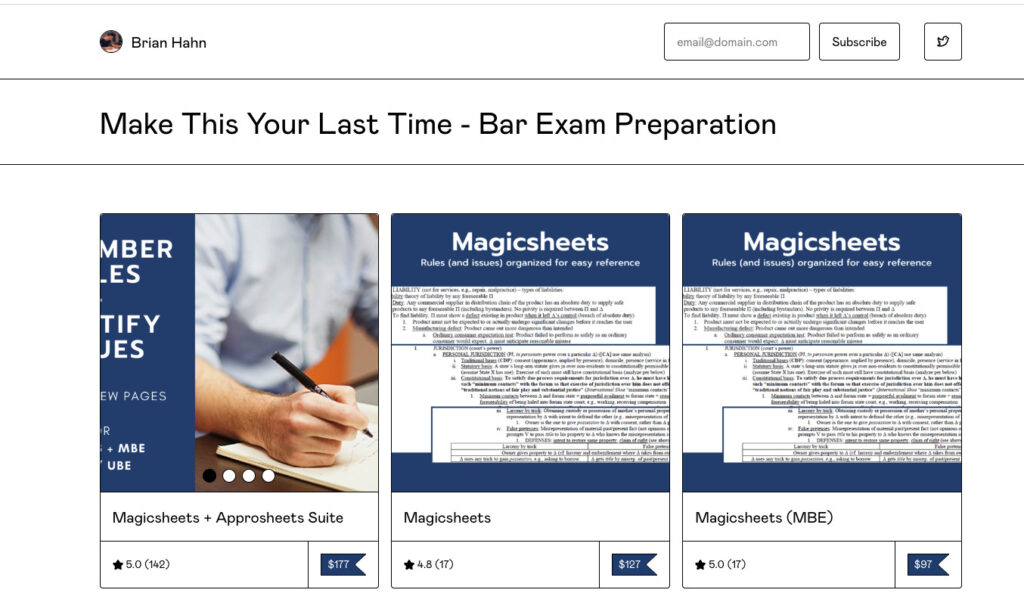
Overall impressions
Gumroad’s community-building features aren’t quite what you might want for the price. But there’s enough here to get started with your first digital product. And you won’t have to fork over a lot of cash in the beginning stages.
Sellfy
Main type of digital products sold
Sellfy’s popular with apparel and accessories like mugs and branded knick-knacks. Its digital file hosting and delivery is a handy platform for selling eBooks, printable PDFs, and instructional guides.
A quick summary
Sellfy hosts an eclectic mix of creators who aren’t exclusively digital. You can also use their print-on-demand options if you’re selling accessories and apparel but don’t want a physical footprint for your business.
Starting from pricing
Opt for $19/month with the starter option and you’ll make sales on Sellfy—albeit with an upper ceiling of $10,000 in sales before you have to upgrade.
Examples
King of the Strings had a YouTube audience with over 175,000 subscribers and wanted to find more ways to monetize it. Selling on Sellfy meant eBooks, video lessons, and offering free trial options and digital lessons to help build a newsletter.
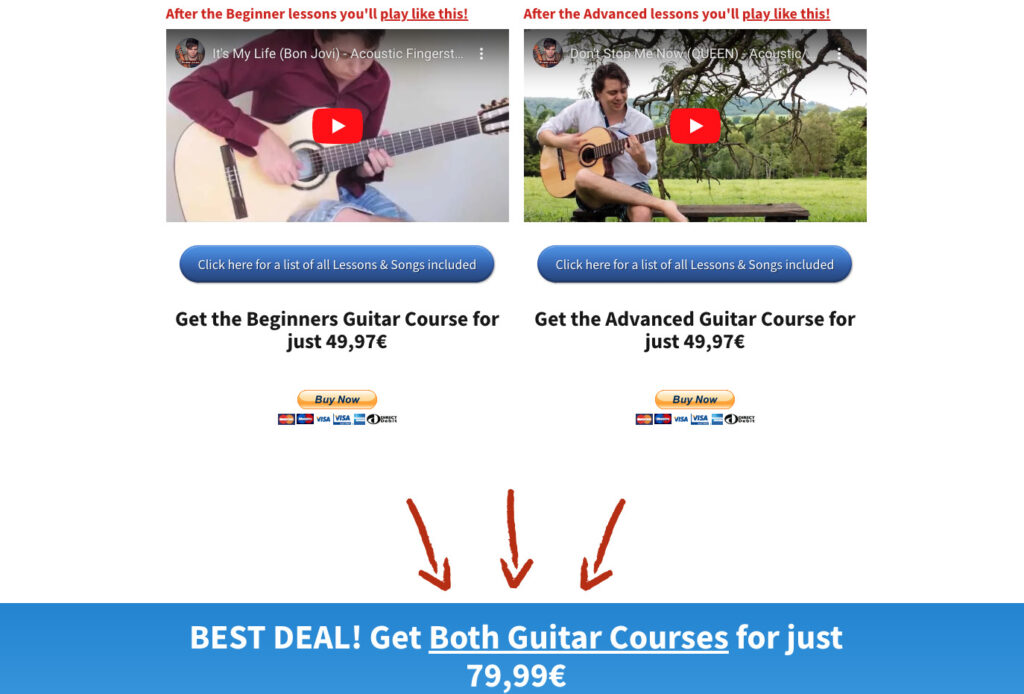
Overall impressions
Sellfy leans more into the apparel and accessories side of things. However, its digital product capabilities are more than enough to get started. Keep in mind: if you anticipate a lot of sales, the flat price will go up.
Payhip
Main type of digital products sold
Digital goods and courses are the name of the game here. Payhip’s friendly to coaches and anyone looking to build a membership community.
A quick summary
Payhip makes it easy to “set up shop” virtually with a web store and offers digital goods and courses. You can also connect custom domains to maintain a consistent brand for your offerings.
Starting from pricing
Starting at $0/month, Payhip’s catch is a 5% transaction fee. That puts it on par with Etsy and less than others, but it can still eat into your profits. If you pay more monthly, you can bring that fee down: the first tier runs $29/month.
Examples
Crystal Dawn Culinary is all about plant-based food. But it’s not just classes. Digital products like downloadable recipes and culinary courses help scale the business.
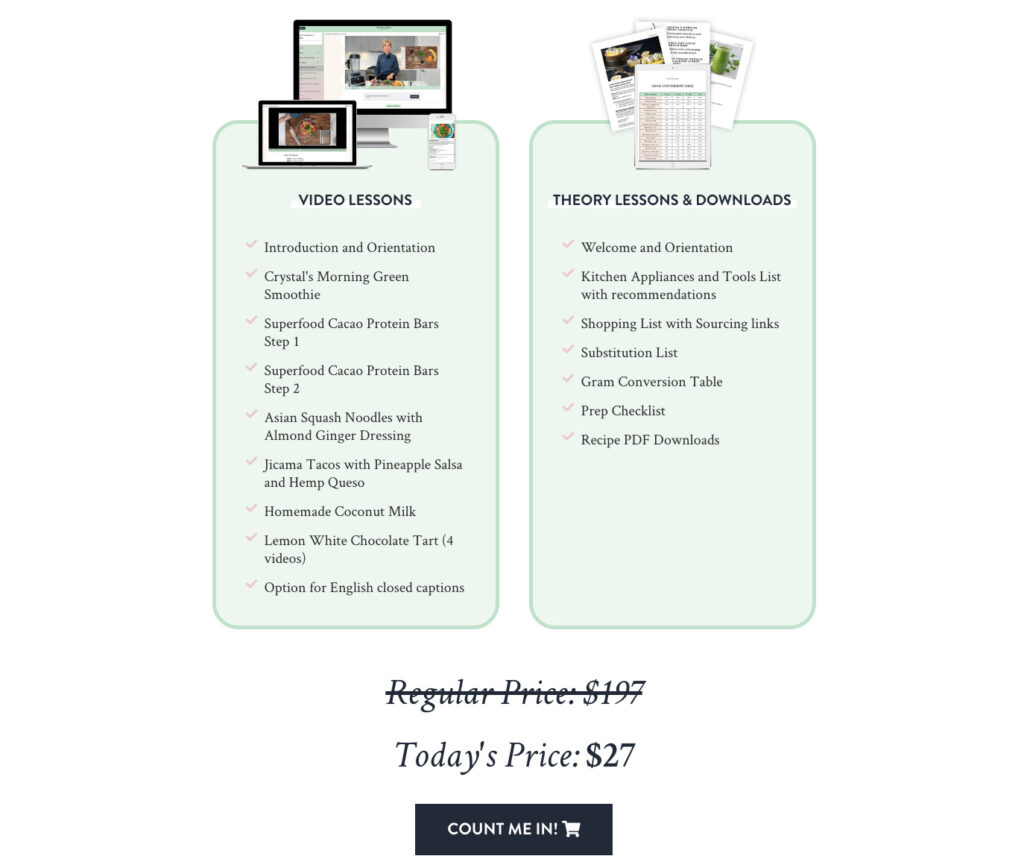
Overall impressions
Payhip is a nice option for anyone who wants to get started and wants a whole system for selling digital products online. But AWeber’s landing page and additional newsletter features will likely give it an edge in this department.
Podia
Main type of digital products sold
Podia’s an all-in-one platform for building your physical goods store online. It also offers plenty of features for courses, coaching, eBooks, webinars, and workshops.
A quick summary
Don’t have a community? Podia’s an excellent way to kickstart audience interest. They also offer a lot of customer support for getting set up for the first time, which makes Podia effective for beginners who aren’t tech-savvy.
Starting from pricing
$0/month, with 8% fees. If your business takes off, you’ll have to pay $33/month to unlock unlimited sales and downloads for your digital products. If you already have customers, $33/month is your real starter price.
Examples
Becky Mollenkamp is a business mindset coach. She leveraged Podia’s community-building features to stack on top of her existing courses. In doing so, she supercharged the engagement she was getting from clients.
The community memberships alone eventually drove $10,000/year in income.
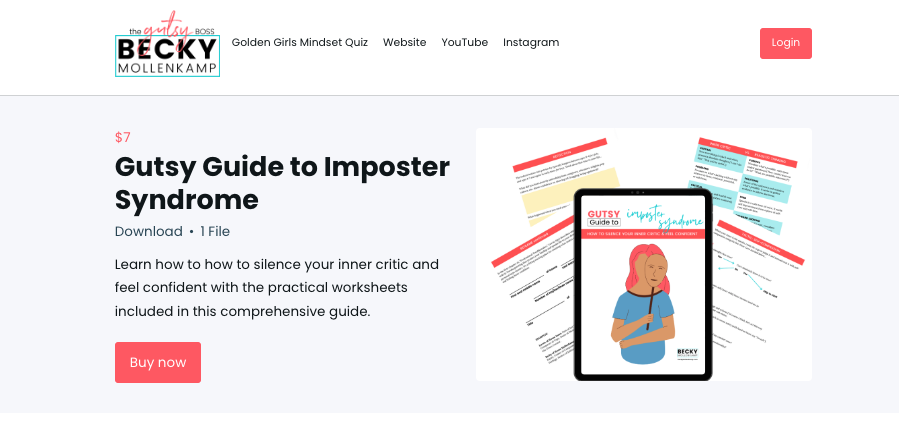
Overall impressions
Podia’s another all-in-one experience if you’re going from zero web presence to selling your first digital products.
SendOwl
Main type of digital products sold
SendOwl creates a simple infrastructure for selling all sorts of digital products.
Subscriptions? Music sheets? How-to guides and hobbyist content?
Sure. Even software presets (like templates for Adobe Lightroom photographers) are easy to sell with SendOwl.
A quick summary
SendOwl leans heavily into the digital side of product sales. They’ll give you the features you need for coupon codes, building “Drip” content, or creating on-site checkout features. They fit nicely into your web presence if you already have an existing community and website and simply want to monetize.
Starting from pricing
You can start with 3 free months, then $9/month—there’s also a per-order management fee of 5%.
Examples
Nicole Young was a SendOwl customer who found success selling photography presets and eBooks. She also enjoyed linking SendOwl with Shopify to combine the features of both platforms.
Overall impressions
SendOwl is more for people who aren’t looking to build a community, but to monetize. Typically, this means you’ll already have an audience willing and waiting to buy.
SamCart
Main type of digital products sold
Health & fitness, business & finance, self-help, and creative digital products are trendy over at SamCart.
A quick summary
SamCart offers plenty of solutions for monetizing courses and adding digital products to an existing page. They offer mobile-friendly features as well. Their no-code, checkout-anywhere add-on is especially convenient.
Starting from pricing
A little heftier than other options at $79/month starting out—but without any mention of transaction fees.
Examples
Fit with Mommy Lu offers an online workout/dance class that customers can stream to home devices. It’s the modern-day equivalent of home workout tapes and DVDs—but it’s much easier to sell.
Overall impressions
The digital product sales tools are spiffy. But you may find its community-building features lacking, especially if you’re starting from scratch.
Where to sell digital products
Being a full-time creator should come with real freedom and flexibility. Selling your services isn’t always the path to get there. To extend your reach, you may eventually have to sell digital products.
After all, you can’t scale a one-on-one service. But you can scale your business when your landing page does all the selling for you.
The result: less time, more money, and a business you’re much happier with.
AWeber is the complete email provider and digital sales platform you’ll need to get started. Play with our landing page builder and see how easy it can be to sell your products even when you’re off doing anything else.